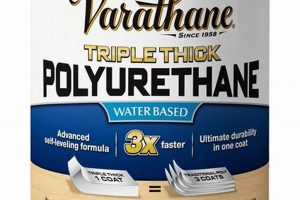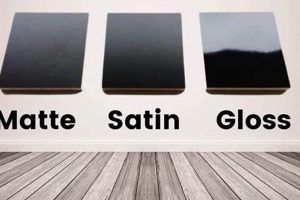Photographic or art reproductions lacking a glossy sheen possess a non-reflective surface. This characteristic arises from the paper’s texture and the ink absorption properties during the printing process. For instance, a photograph printed on heavyweight card stock with a subtle texture will exhibit this appearance, minimizing glare and reflections.
This surface quality is advantageous in situations where visual distractions need to be minimized. It is beneficial for displaying artwork in brightly lit environments or for pieces that are intended to be viewed from multiple angles. Historically, this finish has been favored for archival purposes due to its reduced susceptibility to fingerprints and scratches, contributing to the longevity of the image.
Understanding the characteristics of this particular finish is essential when selecting the appropriate printing method and materials for various applications. The subsequent sections will delve into specific aspects of achieving this effect, including paper selection, ink considerations, and framing recommendations.
Considerations for Utilizing Matte Finish Prints
Achieving optimal results with prints lacking a glossy surface requires careful attention to detail throughout the production process. The following considerations are designed to enhance the visual impact and longevity of such prints.
Tip 1: Paper Selection: Opt for papers specifically manufactured with a matte coating or texture. These papers are engineered to absorb ink evenly, preventing a splotchy or uneven appearance. Examples include archival matte paper and textured fine art paper.
Tip 2: Ink Compatibility: Use pigment-based inks for enhanced color longevity and resistance to fading. Dye-based inks, while often more vibrant initially, are more susceptible to degradation over time, particularly with exposure to light.
Tip 3: Resolution Optimization: Ensure that the image resolution is sufficiently high for the intended print size. A lower resolution image will be more noticeable on a matte surface due to the absence of glare masking imperfections.
Tip 4: Lighting Considerations: When displaying prints of this nature, consider the ambient lighting. While these surfaces minimize glare, direct sunlight or harsh artificial light can still wash out colors and reduce contrast. Diffuse lighting is generally preferable.
Tip 5: Framing and Mounting: Utilize acid-free mats and backboards when framing. This will prevent chemical reactions between the print and the framing materials, preserving the print’s integrity over the long term. Consider UV-protective glazing to further safeguard against fading.
Tip 6: Handling Precautions: Due to the porous nature of paper with a matte finish, handle prints with care to avoid fingerprints or smudges. Wearing cotton gloves is recommended during handling, especially for archival prints.
Tip 7: Color Calibration: Calibrate your monitor and printer to ensure accurate color reproduction. Color variations between the digital image and the final print can be more pronounced on a matte surface, necessitating precise calibration.
These considerations highlight the importance of a comprehensive approach to producing and preserving prints that do not possess a glossy sheen. By addressing these factors, it is possible to achieve visually appealing and enduring results.
The next section will explore common applications and use cases for images lacking a glossy surface.
1. Reduced Glare
The property of reduced glare is a defining characteristic and significant advantage associated with images rendered without a glossy sheen. This attribute directly influences the viewing experience, making such prints suitable for a wide range of applications.
- Ambient Light Mitigation
This refers to the ability of a surface lacking a glossy sheen to minimize the reflection of ambient light sources. Unlike glossy surfaces that reflect light directly, creating distracting specular highlights, prints of this nature scatter light, resulting in a softer, more diffuse reflection. This characteristic is particularly beneficial in environments with uncontrolled or variable lighting conditions, such as offices, homes, or galleries.
- Enhanced Visibility of Detail
By minimizing reflective interference, such prints enhance the visibility of subtle details within the image. The absence of harsh highlights allows viewers to perceive tonal gradations and fine textures more clearly. This is particularly important for images with intricate compositions or delicate shading, where the presence of glare could obscure crucial visual information.
- Improved Viewing Angle Tolerance
The scattering of light, rather than direct reflection, provides for a wider viewing angle tolerance. A glossy surface often exhibits significant variations in brightness and contrast depending on the viewing angle. Images rendered without a glossy surface, however, maintain a more consistent appearance across a broader range of viewing positions, making them suitable for display in areas where viewers may approach the artwork from different angles.
- Minimized Eye Strain
Prolonged viewing of glossy surfaces can contribute to eye strain due to the constant adjustment required to compensate for reflections. The absence of glare on prints of this nature reduces this strain, making them more comfortable to view for extended periods. This factor is particularly relevant in settings where individuals may be spending considerable time in the presence of displayed images.
In conclusion, the reduced glare associated with images rendered without a glossy sheen offers significant advantages in terms of visibility, viewing comfort, and suitability for diverse display environments. These characteristics make them a preferred choice in situations where minimizing distractions and maximizing visual clarity are paramount.
2. Ink Absorption and Matte Finish Prints
Ink absorption is a critical factor in achieving the desired aesthetic and functional properties of images rendered without a glossy surface. The interaction between the ink and the paper’s surface directly impacts color fidelity, image sharpness, and overall print longevity.
- Paper Porosity and Ink Spread
The porosity of the paper stock determines the rate and extent of ink absorption. Papers designed for matte finishes typically possess a higher porosity compared to those intended for glossy prints. This increased porosity facilitates rapid ink uptake, minimizing surface reflection and contributing to the characteristic lack of sheen. However, excessive absorption can lead to ink bleed, resulting in a loss of sharpness and detail, particularly in areas of fine lines or intricate patterns.
- Ink Formulation and Surface Interaction
The formulation of the ink itself plays a crucial role in achieving optimal results. Pigment-based inks, known for their lightfastness and archival qualities, often interact differently with matte papers compared to dye-based inks. Pigment particles tend to remain closer to the paper’s surface, resulting in a more saturated color representation. Dye-based inks, due to their smaller molecular size, penetrate deeper into the paper fibers, potentially affecting color vibrancy and long-term stability.
- Coating Properties and Ink Retention
Many papers designed for matte prints feature a specialized coating that controls ink absorption. This coating helps to regulate the spread of ink, preventing excessive bleed while ensuring sufficient ink retention for optimal color density. The specific composition and application of this coating directly influence the final appearance of the print. Improper coating can lead to uneven ink distribution, resulting in mottled or inconsistent color rendering.
- Drying Time and Image Stability
The rate at which ink dries on the paper’s surface is directly related to the absorption rate. Rapid ink absorption can lead to faster drying times, reducing the risk of smudging or offsetting during handling. However, excessively rapid drying can also result in a loss of color vibrancy or the appearance of banding in areas of solid color. Achieving the optimal balance between absorption rate and drying time is crucial for producing high-quality images lacking a glossy surface with lasting image stability.
These facets of ink absorption underscore the importance of careful material selection and process control when producing images without a glossy surface. By understanding and managing these interactions, it is possible to create visually appealing and durable prints that meet specific aesthetic and archival requirements.
3. Paper Texture and Images Lacking a Glossy Sheen
The tactile quality and surface topography of paper, often referred to as its texture, are integral to the visual characteristics of images rendered without a glossy surface. This texture, determined by the manufacturing process and the raw materials used, directly influences how light interacts with the print, affecting perceived sharpness, color saturation, and overall aesthetic appeal. A rougher texture, for example, scatters light more diffusely, further reducing glare and imparting a softer, more artistic appearance. In contrast, a smoother texture, while still lacking the high reflectivity of glossy paper, allows for greater detail rendition. The choice of paper texture, therefore, becomes a critical decision in achieving the desired artistic effect.
The interplay between paper texture and ink absorption also plays a significant role. More textured papers tend to have greater surface area and increased porosity, influencing how ink is absorbed and distributed. This can lead to a more muted color palette and a softer, less defined image. For instance, fine art prints on watercolor paper, known for its pronounced texture, often exhibit a delicate, painterly quality due to the way the paper fibers interact with the ink. Conversely, smoother, matte-coated papers offer a balance between ink absorption and detail preservation, making them suitable for photographic reproductions where clarity and color accuracy are paramount. Selecting the appropriate paper texture is essential for optimizing the print’s visual impact based on the intended application and artistic vision.
Understanding the relationship between paper texture and images rendered without a glossy sheen is of practical significance for artists, photographers, and printmakers. It enables informed decisions regarding material selection, leading to more predictable and aesthetically pleasing results. While achieving the desired balance between texture, detail, and color rendition can present challenges, particularly when working with complex images or specific artistic styles, a thorough understanding of these interactions is crucial for realizing the full potential of the printing process. Furthermore, awareness of these factors contributes to informed choices in framing and display, ensuring the long-term preservation and appreciation of the artwork.
4. Archival quality
The link between archival quality and images rendered without a glossy surface is significant, stemming from inherent material properties and resulting in enhanced longevity. Archival quality refers to the ability of a print to resist degradation over extended periods, preserving color fidelity and structural integrity. The surface characteristics of such images, specifically their lack of gloss, contribute to this durability in several ways. For instance, the matte surface typically minimizes light reflection, reducing UV exposure and subsequent fading of pigments. Moreover, papers designed for images without a glossy surface frequently incorporate acid-free formulations, preventing chemical reactions that can cause discoloration and embrittlement. These properties directly impact the long-term preservation of the image. As an example, fine art prints intended for museum display or private collections often utilize matte surfaces and archival-grade materials to ensure they maintain their original appearance for generations.
Furthermore, the texture of paper commonly used for matte surfaces offers a practical advantage in terms of handling and display. Their textured surface makes the prints less susceptible to fingerprints and scratches compared to high-gloss alternatives. This resistance minimizes the need for frequent cleaning and reduces the risk of physical damage during handling or transport. In practical applications, this translates to lower maintenance costs for institutions that collect and display prints of this nature. Additionally, the reduced glare from matte surfaces makes these prints more suitable for environments with varied lighting conditions, preventing distracting reflections that can obscure the image and potentially accelerate its deterioration. Therefore, the selection of a matte surface is often a deliberate choice made to optimize the print’s long-term preservation and display characteristics.
In conclusion, the connection between archival quality and images that lack a glossy sheen is based on a combination of material properties and practical benefits. The reduced light reflection, the use of acid-free materials, and the increased resistance to physical damage all contribute to the superior longevity of these prints. While challenges remain in achieving true archival permanence, the deliberate selection of materials and processes that prioritize these qualities remains essential for ensuring that images rendered without a glossy surface retain their aesthetic and historical value for future generations.
5. Color Accuracy
Color accuracy, defined as the faithfulness of color reproduction from an original image to its printed counterpart, is a paramount consideration when producing images rendered without a glossy surface. The interaction between ink, paper, and printing technology significantly impacts the ability to achieve precise color representation.
- Gamut Mapping and Color Space Conversion
Gamut mapping, the process of translating colors from a source color space (e.g., Adobe RGB) to the printer’s color gamut, is crucial. Matte surfaces often exhibit a smaller color gamut compared to glossy surfaces. Therefore, careful color space conversion is essential to avoid clipping or inaccurate rendering of saturated colors. For example, deep blues and vibrant greens may require careful adjustment to ensure they fall within the printable range without significant alteration.
- Ink Absorption and Color Density
The rate and extent of ink absorption by the paper significantly affect color density and vibrancy. Excessive ink absorption can lead to muted colors and a loss of contrast, while insufficient absorption can result in a washed-out appearance. Matte papers, due to their porous nature, require precise ink management to achieve accurate color representation. Specialized profiling techniques are often employed to compensate for these variations.
- Metamerism and Viewing Conditions
Metamerism, the phenomenon where colors appear different under varying light sources, poses a challenge to color accuracy. Matte surfaces, with their non-reflective properties, can exacerbate metameric effects. Therefore, it’s crucial to evaluate color accuracy under standardized viewing conditions (e.g., D50 lighting) to ensure consistent color perception regardless of the ambient light. Standardized viewing booths are frequently used in professional printing environments for this purpose.
- Printer Calibration and Profiling
Accurate printer calibration and profiling are indispensable for achieving color accuracy on matte surfaces. Printer profiles, generated using spectrophotometers, characterize the printer’s color response and compensate for deviations from the intended color values. Regular calibration ensures consistent color reproduction over time, minimizing the impact of environmental factors such as temperature and humidity on ink performance. Custom profiles tailored to specific paper and ink combinations are often necessary for demanding applications.
These considerations highlight the complex interplay of factors that influence color accuracy in images rendered without a glossy surface. The challenges posed by gamut limitations, ink absorption, metamerism, and printer calibration necessitate a comprehensive understanding of color management principles and the use of specialized tools and techniques. By addressing these factors, it is possible to achieve faithful color reproduction and meet the stringent requirements of professional printing applications.
6. Surface handling
The physical manipulation of images rendered without a glossy surface presents unique considerations due to the inherent characteristics of the paper and ink. A matte finish lacks the protective layer afforded by a glossy coating, leaving the ink and paper fibers more vulnerable to damage from direct contact. Consequently, fingerprints, smudges, and abrasions are more easily imprinted onto the surface, potentially compromising the aesthetic value and longevity of the print. This increased susceptibility to damage necessitates careful handling protocols throughout the entire lifecycle of the print, from production to display. For example, a fine art print on uncoated cotton rag paper requires the use of cotton gloves during handling to prevent the transfer of oils and contaminants from human skin. The absence of such precautions can result in permanent blemishes, diminishing the print’s value and visual appeal.
The implications of surface handling extend beyond mere aesthetics and can impact the archival stability of matte finish prints. The introduction of contaminants, such as oils or acids from fingerprints, can initiate chemical reactions that accelerate the degradation of the paper fibers and the fading of the ink. This is particularly relevant for prints intended for long-term preservation, such as photographs in historical archives or limited-edition art prints. In these cases, proper handling procedures, including the use of acid-free enclosures and framing materials, are essential to mitigate the risk of damage and ensure the print’s continued preservation. Moreover, the method of cleaning matte surface prints must be carefully considered, as abrasive cleaners or excessive pressure can permanently alter the surface texture and compromise the image quality. Gentle dusting with a soft brush or microfiber cloth is often the recommended approach.
In conclusion, surface handling is a critical aspect of maintaining the integrity and longevity of images rendered without a glossy surface. The absence of a protective coating makes these prints more vulnerable to damage from direct contact and environmental contaminants. Implementing careful handling procedures, utilizing appropriate storage materials, and employing gentle cleaning techniques are essential for preserving the aesthetic value and archival stability of matte finish prints. Neglecting these considerations can lead to irreversible damage, diminishing the print’s value and compromising its long-term preservation.
Frequently Asked Questions about Matte Finish Prints
This section addresses common inquiries regarding images rendered without a glossy surface, providing factual information and clarifying misconceptions.
Question 1: Are images rendered without a glossy surface suitable for all types of photography?
The suitability depends on the intended aesthetic and display environment. Prints lacking a glossy surface excel in minimizing glare and showcasing subtle details, making them ideal for portraits, landscapes, and fine art photography. However, they may not be the optimal choice for images requiring high contrast and vibrant colors, where a glossy surface might be preferred.
Question 2: Do images rendered without a glossy surface fade more quickly than glossy prints?
The fading rate depends more on the ink and paper quality than the surface finish. Archival-quality inks and acid-free papers are crucial for longevity. Properly stored images rendered without a glossy surface, utilizing these materials, can exhibit excellent fade resistance, often surpassing that of lower-quality glossy prints.
Question 3: Can fingerprints be removed from images rendered without a glossy surface?
Removing fingerprints from these surfaces is challenging due to their porous nature. Prevention is the best approach; handling prints with clean, lint-free gloves is recommended. Attempting to clean the surface can easily cause smudging or damage, so professional conservation is advised for valuable prints.
Question 4: Are images rendered without a glossy surface more expensive to produce than glossy prints?
The cost varies depending on the specific materials and printing techniques employed. High-quality archival papers and pigment-based inks, often used with images rendered without a glossy surface, can be more expensive than standard materials. However, the overall cost difference may be negligible depending on the print volume and equipment used.
Question 5: Do images rendered without a glossy surface require special framing?
While special framing is not strictly required, archival-quality materials are recommended for long-term preservation. Acid-free mats and UV-protective glazing can help protect the print from environmental factors such as humidity and light. These measures contribute to the print’s overall longevity and value.
Question 6: Are images rendered without a glossy surface easier to view in brightly lit environments?
Yes, a significant advantage of these prints is their ability to minimize glare, making them easier to view in brightly lit environments. The matte surface diffuses light, reducing reflections and allowing viewers to see the image clearly without distractions.
In summary, prints lacking a glossy surface present a distinct aesthetic and functional profile. Key considerations involve material selection, handling protocols, and understanding the impact of environmental factors.
The subsequent section will offer guidelines on selecting the appropriate printing method for achieving optimal results with images rendered without a glossy surface.
Conclusion
This exploration of matte finish prints has elucidated their defining characteristics, advantages, and considerations. The absence of glare, the unique ink absorption properties, and the archival potential have been outlined, emphasizing the suitability of these prints for diverse applications ranging from fine art to photographic documentation. Understanding the nuances of paper texture, color accuracy, and surface handling is crucial for achieving optimal results and ensuring the longevity of the printed image.
The informed selection and utilization of matte finish prints represent a commitment to both aesthetic excellence and enduring quality. Continued advancements in printing technology and material science promise to further enhance the capabilities and broaden the applications of this versatile medium. By embracing a comprehensive understanding of these principles, professionals and enthusiasts alike can leverage the unique attributes of matte finish prints to create impactful and lasting visual narratives.







